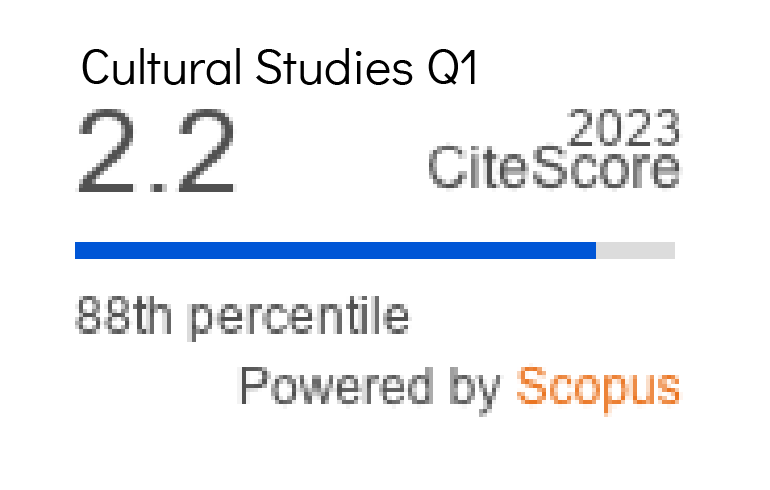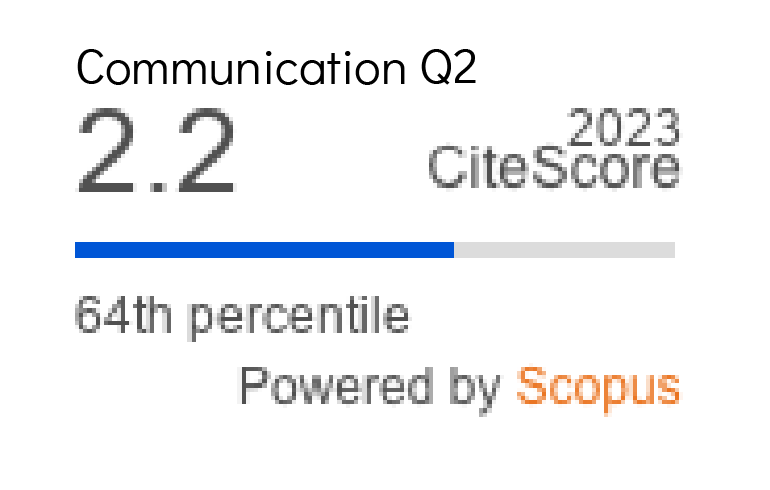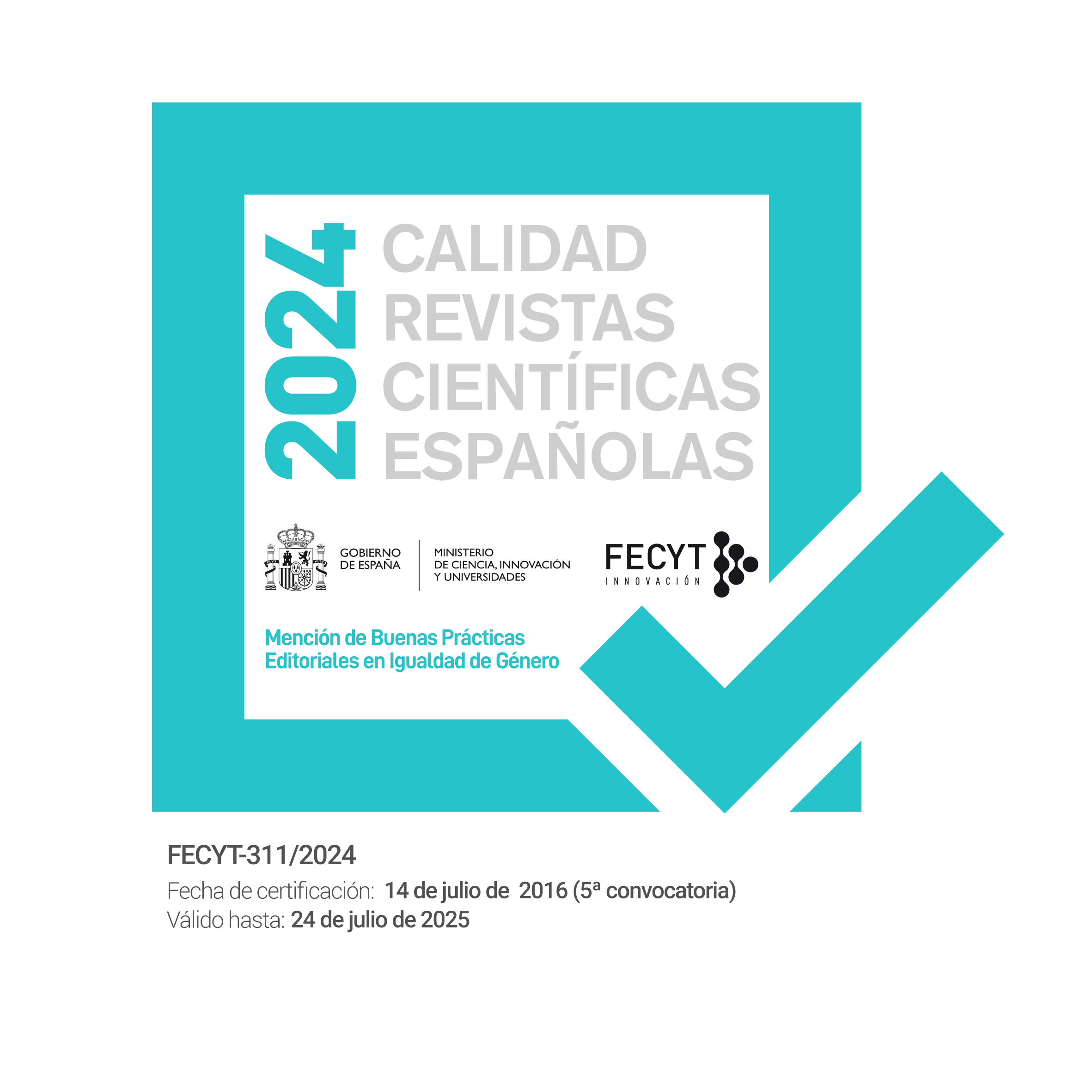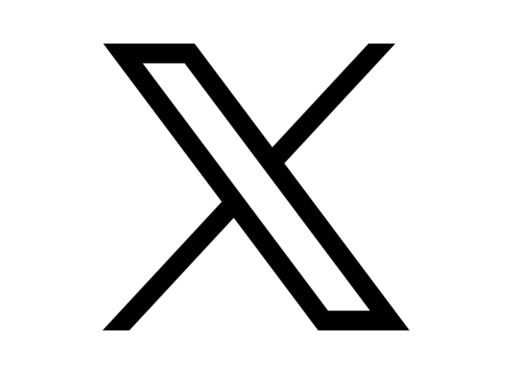¿Quién lidera la conversación? Los usuarios influyentes de Twitter durante un evento deportivo de nicho
DOI:
https://doi.org/10.14198/MEDCOM.20488Palabras clave:
AHP, ciclismo, deportes de nicho, eventos deportivos, usuarios influyentes, Twitter.Resumen
Los seguidores de los deportes de nicho suelen encontrar escaso contenido en los medios de comunicación debido a su limitada audiencia. En cambio, los medios sociales permiten seguir estos deportes específicos. El dinamismo de estos medios se basa en la participación individual, de tal forma que usuarios prominentes conducen la conversación social gracias a su capacidad de influencia. Sin embargo, la complejidad del concepto de influencia dificulta identificar a estos usuarios clave. Nuestra investigación propone una medida de la influencia en Twitter basada en variables obtenidas de la plataforma (número de tweets, número de retweets y número de seguidores) y otras calculadas a partir del Análisis de Redes Sociales (outdegree, indegree y PageRank). Para componer este índice se utilizó el Proceso de Jerarquía Analítica. Esta medida se aplicó a la conversación generada en Twitter en torno a los Mundiales de Ciclismo en Pista 2018. A partir de un corpus de 19.701 tweets, identificamos a los 25 usuarios más influyentes del evento. Los resultados indican que los organizadores y ciclistas participantes jugaron un papel relevante en Twitter. Además, la distribución geográfica de estos usuarios influyentes reflejó la dependencia cultural que tienen los deportes de nicho.
Citas
Abeza, G.; Pegoraro, A.; Naraine, M. L.; Séguin, B. & O’Reilly, N. (2014). Activating a global sport sponsorship with social media: An analysis of TOP sponsors, Twitter, and the 2014 Olympic Games. International Journal of Sport Management and Marketing, 15(3-4), 184–213. http://dx.doi.org/10.1504/IJSMM.2014.072010
Albero-Gabriel, J. (2014). Twitter, #primaveravalenciana y generación de noticias. CIC Cuadernos de Información y Comunicación, 19(0), 253–269. http://dx.doi.org/10.5209/rev_ciyc.2014.v19.43914
Anderson, C. (2006). The Long Tail: Why the Future of Business is Selling Less of More. New York: Hyperion.
Bakshy, E.; Mason, W. A.; Hofman, J. M. & Watts, D. J. (2011). Everyone’s an influencer: Quantifying influence on twitter. In Proceedings of the 4th ACM International Conference on Web Search and Data Mining, WSDM 2011 (pp. 65-74). http://dx.doi.org/10.1145/1935826.1935845
Bastian, M.; Heymann, S. & JACOMY, M. (2009). Gephi: An open source software for exploring and manipulating networks. In International AAAI Conference on Weblogs and Social Media (pp. 361–362).
Baviera-Puig, A.; García-Melón, M.; Ortolá, M. D. & López-Cortés, I. (2021). Proposal of a New Orange Selection Process Using Sensory Panels and AHP. International Journal of Environmental Research and Public Health, 18(7), 3333. http://dx.doi.org/10.3390/ijerph18073333
Biasco-Duatis, M. y Coenders, G. (2020). Análisis de sentimiento de la agenda de los partidos políticos españoles en Twitter durante la Moción de Censura de 2018. Un enfoque de datos composicionales. Revista Mediterránea de Comunicación, 11(2), 185–198. http://dx.doi.org/10.14198/MEDCOM2020.11.2.22
Blaszka, M.; Burch, L. M.; Frederick, E. L.; Clavio, G. & Walsh, P. (2016). #WorldSeries: An Empirical Examination of a Twitter Hashtag During a Major Sporting Event. International Journal of Sport Communication, 5(4), 435–453. http://dx.doi.org/10.1123/ijsc.5.4.435
Bouguessa, M. & Romdhane, L. BEN. (2015). Identifying authorities in online communities. ACM Transactions on Intelligent Systems and Technology, 6(3), 1–23. http://dx.doi.org/10.1145/2700481
Cha, M.; Haddadi, H.; Benevenuto, F. & Gummadi, K. P. (2010). Measuring User Influence in Twitter: The Million Follower Fallacy. In 4th International AAAI Conference on Weblogs and Social Media (ICWSM).
Chan-Olmsted, S. & Xiao, M. (2019). Smart Sports Fans: Factors Influencing Sport Consumption on Smartphones. Sport Marketing Quarterly, 28(4), 181–194. http://dx.doi.org/10.32731/smq.284.122019.01
Clavio, G.; Walsh, P. & Vooris, R. (2013). The utilization of Twitter by drivers in a major racing series. International Journal of Motorsport Management, 2(1), 2.
De Nooy, W.; Mrvar, A. & Bategelj, V. (2005). Exploratory Social Network Analysis with Pajek. Cambridge: Cambridge University Press. http://dx.doi.org/10.1017/cbo9780511806452
Delia, E. B. & Armstrong, C. G. (2015). #Sponsoring the #FrenchOpen: An examination of social media buzz and sentiment. Journal of Sport Management, 29(2), 184–199. http://dx.doi.org/10.1123/JSM.2013-0257
Denia, E. (2021). Twitter como objeto de investigación en comunicación de la ciencia. Revista Mediterránea de Comunicación, 12(1), 289–301. http://dx.doi.org/10.14198/MEDCOM000006
Dubois, E. & Gaffney, D. (2014). The Multiple Facets of Influence: Identifying Political Influentials and Opinion Leaders on Twitter. American Behavioral Scientist, 58(10), 1260–1277. http://dx.doi.org/10.1177/0002764214527088
Gayo-Avello, D. (2013). Nepotistic relationships in twitter and their impact on rank prestige algorithms. Information Processing & Management, 49(6), 1250-1280. http://dx.doi.org/10.1016/j.ipm.2013.06.003
González, L. M.; Devís-Devís, J.; Pellicer-Chenoll, M.; Pans, M.; Pardo-Ibañez, A.; García-Massó, X.; Peset, F., Garzón-Farinós, F. & Pérez-Samaniego, V. (2021). The impact of COVID-19 on sport in Twitter: A quantitative and qualitative content analysis. International Journal of Environmental Research and Public Health, 18(9). http://dx.doi.org/10.3390/ijerph18094554
González-Bailón, S.; Borge-Holthofer, J. & Moreno, Y. (2013). Broadcasters and Hidden Influentials in Online Protest Diffusion. American Behavioral Scientist, 57(7), 943–965. http://dx.doi.org/10.1177/0002764213479371
Greenhalgh, G. P. & Greenwell, T. C. (2013). Professional niche sports sponsorship: an investigation of sponsorship selection criteria. International Journal of Sports Marketing and Sponsorship, 14(2), 2–19. http://dx.doi.org/10.1108/ijsms-14-02-2013-b002
Greenwell, T. C.; Greenhalgh, G. & Stover, N. (2013). Understanding spectator expectations: An analysis of niche sports. International Journal of Sport Management and Marketing, 13(3-4), 144-157. http://dx.doi.org/10.1504/IJSMM.2013.059720
Gross, J. & Von Wangenheim, F. (2018). The Big Four of Influencer Marketing. A Typology of Influencers. Marketing Review St. Gallen, 2, 30–38.
Hambrick, M. E. (2016). Six Degrees of Information: Using Social Network Analysis to Explore the Spread of Information Within Sport Social Networks. International Journal of Sport Communication, 5(1), 16–34. http://dx.doi.org/10.1123/ijsc.5.1.16
Hambrick, M. E. & Sanderson, J. (2013). Gaining Primacy in the Digital Network: Using Social Network Analysis to Examine Sports Journalists’ Coverage of the Penn State Football Scandal via Twitter. Journal of Sports Media, 8(1), 1–18. http://dx.doi.org/10.1353/jsm.2013.0003
Hambrick, M. E.; Simmons, J. M.; Greenhalgh, G. P. & Greenwall, T. C. (2010). Understanding Professional Athletes’ Use of Twitter: A Content Analysis of Athlete Tweets. International Journal of Sport Communication, 3(4), 454–471. http://dx.doi.org/10.1123/ijsc.3.4.454
Huang, Y.; Shen, C. & Li, T. (2018). Event summarization for sports games using Twitter streams. World Wide Web, 21(3), 609–627. http://dx.doi.org/10.1007/s11280-017-0477-6
Hutchins, B. (2011). The acceleration of media sport culture: Twitter, telepresence and online messaging. Information Communication and Society, 14(2), 237–257. http://dx.doi.org/10.1080/1369118X.2010.508534
Jensen, R. W.; Limbu, Y. B. & Spong, Y. (2015). Visual Analytics of Twitter Conversations about Corporate Sponsors of FC Barcelona and Juventus at the 2015 UEFA Final. International Journal of Sports Marketing & Sponsorship, 16(4), 3–9.
Kang, S. J.; Rice, J. A.; Hambrick, M. E. & Choi, C. (2019). CrossFit across Three Platforms: Using Social Media to Navigate Niche Sport Challenges. Physical Culture and Sport. Studies and Research, 81, 36–46. http://dx.doi.org/10.2478/pcssr-2019-0004
Kassing, J. W. & Sanderson, J. (2010). Fan–Athlete Interaction and Twitter Tweeting Through the Giro: A Case Study. International Journal of Sport Communication, 3(1), 113–128. http://dx.doi.org/10.1123/ijsc.3.1.113
Katz, E. (1957). The Two-Step Flow of Communication: An Up-To-Date Report on an Hypothesis. Public Opinion Quarterly, 21(1), 61–78. http://dx.doi.org/10.1086/266687
Kwak, H.; Lee, C.; Park, H. & Moon, S. (2010). What is Twitter, a social network or a news media? In Proceedings of the 19th International Conference on World Wide Web (pp. 591–600). http://dx.doi.org/10.1145/1772690.1772751
Lamirán-Palomares, J. M.; Baviera, T. & Baviera-Puig, A. (2020). Sports influencers on Twitter. Analysis and comparative study of Track Cycling World Cups 2016 and 2018. Social Sciences, 9(10), 1–23. http://dx.doi.org/10.3390/socsci9100169
Lara-Navarra, P.; López-Burrull, A.; Sánchez-Navarro, J. y Yànez, P. (2018). Medición de la influencia de usuarios en redes sociales: propuesta SocialEngagement. El Profesional de La Información, 27(4), 899–908. http://dx.doi.org/10.3145/epi.2018.jul.18
Lee, S. & Walsh, P. (2011). SWOT and AHP hybrid model for sport marketing outsourcing using a case of intercollegiate sport. Sport Management Review, 14(4), 361–369. http://dx.doi.org/10.1016/j.smr.2010.12.003
Marin-Garcia, J. A.; Aragonés-Beltrán, P. y García Melón, M. (2014). Consistencia intra e inter evaluador de la comparación pareada en la evaluación de la competencia de innovación de estudiantes universitarios. WPOM-Working Papers on Operations Management, 5(2), 24. https://doi.org/10.4995/wpom.v5i2.3220
Mastromartino, B.; Qian, T. Y.; Wang, J. J. & Zhang, J. J. (2020). Developing a fanbase in niche sport markets: An examination of NHL fandom and social sustainability in the sunbelt. Sustainability, 12(3). http://dx.doi.org/10.3390/su12031115
Mccombs, M. & Shaw, D. (1972). The Agenda-Setting Function of Mass Media. The Public Opinion Quarterly, 36(2), 176-187.
Meenaghan, T.; Mcloughin, D. & McCormack, A. (2013). New Challenges in Sponsorship Evaluation Actors, New Media, and the Context of Praxis. Psychology & Marketing, 30(5), 444–460. http://dx.doi.org/10.1002/mar.20618
Méndez-Guzmán, E.; Zhang, Z. & Ahmed, W. (2021). Towards understanding a football club’s social media network: an exploratory case study of Manchester United. Information Discovery and Delivery, 49(1), 71–83. http://dx.doi.org/10.1108/IDD-08-2020-0106
Miloch, K. S. & Lambrecht, K. W. (2006). Consumer awareness of sponsorship at grassroots sport events. Sport Marketing Quarterly, 15(3), 147–154.
Naraine, M. L. (2019). Follower Segments Within and Across the Social Media Networks of Major Professional Sport Organizations. Sport Marketing Quarterly, 28(4), 222-233. http://dx.doi.org/10.32731/smq.284.122019.04
Naraine, M. L.; Schenk, J. & Parent, M. M. (2016). Coordination in international and domestic sports events: Examining stakeholder network governance. Journal of Sport Management, 30(5), 521-537. http://dx.doi.org/10.1123/jsm.2015-0273
Nisar, T. M.; Prabhakar, G. & Patil, P. P. (2018). Sports clubs’ use of social media to increase spectator interest. International Journal of Information Management, 43, 188–195. http://dx.doi.org/10.1016/j.ijinfomgt.2018.08.003
Page, L. & Brin, S. (1998). The anatomy of a large-scale hypertextual Web search engine. Computer Networks, 30(1-7), 107-117. http://dx.doi.org/10.1016/s0169-7552(98)00110-x
Pegoraro, A. (2016). Look Who’s Talking—Athletes on Twitter: A Case Study. International Journal of Sport Communication, 3(4), 501–514. http://dx.doi.org/10.1123/ijsc.3.4.501
Riquelme, F. & González-Cantergiani, P. (2015). Measuring user influence on Twitter: A survey. Information Processing and Management, 52(5), 949–975. http://dx.doi.org/10.1016/j.ipm.2016.04.003
Rubio García, R. (2014). Twitter y la teoría de la AgendaSetting: mensajes de la opinión pública digital. Estudios sobre el Mensaje Periodístico, 20(1), 249–264. http://dx.doi.org/10.5209/rev_ESMP.2014.v20.n1.45230
Saaty, T. (1980). The analytic hierarchy process: Planning, priority setting, resource allocation. New York: McGraw-Hill.
Saaty, T. L. (2008). Decision making with the analytic hierarchy process. International Journal of Services Sciences, 1(1), 83–98. http://dx.doi.org/10.1504/IJSSCI.2008.017590
Sanderson, J. & Hambrick, M. E. (2016). Covering the Scandal in 140 Characters: A Case Study of Twitter’s Role in Coverage of the Penn State Saga. International Journal of Sport Communication, 5(3), 384–402. http://dx.doi.org/10.1123/ijsc.5.3.384
Santomier, J. (2008). New media, branding and global sports sponsorship. International Journal of Sports Marketing and Sponsorship, 10(1), 15–28. http://dx.doi.org/10.1108/ijsms-10-01-2008-b005
Scelles, N.; Helleu, B.; Durand, C.; Bonnal, L. & Morrow, S. (2017). Explaining the number of social media fans for North American and European professional sports clubs with determinants of their financial value. International Journal of Financial Studies, 5(4), 1–20. http://dx.doi.org/10.3390/ijfs5040025
Scott, J. (2017). Social Network Analysis. Londres: SAGE.
Sinuany-Stern, Z. (1988). Ranking of sports teams via the AHP. Journal of the Operational Research Society, 39(7), 661–667. http://dx.doi.org/10.1057/jors.1988.112
Smith, L. R.; Pegoraro, A. & Cruikshank, S. A. (2019). Tweet, Retweet, Favorite: The Impact of Twitter Use on Enjoyment and Sports Viewing. Journal of Broadcasting and Electronic Media, 63(1), 94–110. http://dx.doi.org/10.1080/08838151.2019.1568805
Su, Y.; Baker, B. J.; Doyle, J. P. & Kunkel, T. (2020). The Rise of an Athlete Brand: Factors Influencing the Social Media Following of Athletes. Sport Marketing Quarterly, 29, 33–46.
Tafesse, W. & Wood, B. P. (2021). Followers’ engagement with Instagram influencers: The role of influencers’ content and engagement strategy. Journal of Retailing and Consumer Services, 58, 102303. http://dx.doi.org/10.1016/j.jretconser.2020.102303
Thompson, A. J.; Martin, A. J.; Gee, S. & Geurin, A. N. (2018). Building brand and fan relationships through social media. Sport, Business and Management: An International Journal, 8(3), 235–256. http://dx.doi.org/10.1108/SBM-04-2017-0024
Trivedi, J.; Soni, S. & Kishore, A. (2021). Exploring the Role of Social Media Communications in the Success of Professional Sports Leagues: An Emerging Market Perspective. Journal of Promotion Management, 27(2), 306–331. http://dx.doi.org/10.1080/10496491.2020.1829774
Vale, L. & Fernandes, T. (2018). Social media and sports: driving fan engagement with football clubs on Facebook. Journal of Strategic Marketing, 26(1), 37–55.
http://dx.doi.org/10.1080/0965254X.2017.1359655
Veglis, A. & Maniou, T. A. (2018). The mediated data model of communication flow: Big data and data journalism. Kome, 6(2), 32–43. http://dx.doi.org/10.17646/KOME.2018.23
Wang, X. (2015). Using attitude functions, self-efficacy, and norms to predict attitudes and intentions to use mobile devices to access social media during sporting event attendance. Mobile Media & Communication, 3(1), 75–90. http://dx.doi.org/10.1177/2050157914548932
Wang, Y. (2021). Building relationships with fans: How sports organizations used Twitter as a communication tool. Sport in Society, 24(7), 1055–1069. http://dx.doi.org/10.1080/17430437.2020.1725475
Wäsche, H. (2015). Interorganizational cooperation in sport tourism: A social network analysis. Sport Management Review, 18(4), 542–554. http://dx.doi.org/10.1016/j.smr.2015.01.003
Wäsche, H.; Dickson, G.; Woll, A. & Brandes, U. (2017). Social network analysis in sport research: an emerging paradigm. European Journal for Sport and Society, 14(2), 138–165. http://dx.doi.org/10.1080/16138171.2017.1318198
Wasserman, S. & Faust, K. (1994). Social Network Analysis: methods and applications. Cambridge: Cambridge University Press. http://dx.doi.org/10.1017/CBO9780511815478
Yan, G.; Watanabe, N. M.; Shapiro, S. L.; Naraine, M. L. & Hull, K. (2019). Unfolding the Twitter scene of the 2017 UEFA Champions League Final: social media networks and power dynamics. European Sport Management Quarterly, 19(4), 419–436. http://dx.doi.org/10.1080/16184742.2018.1517272
Zhang, Y.; Moe, W. W. & Schweidel, D. A. (2017). Modelling the role of message content and influencers in social media rebroadcasting. International Journal of Research in Marketing, 34(1), 100–119. http://dx.doi.org/10.1016/j.ijresmar.2016.07.003
Descargas
Estadísticas
Publicado
Cómo citar
Número
Sección
Licencia
Derechos de autor 2018 José María Lamirán Palomares, Amparo Baviera-Puig, Tomás Baviera Puig

Esta obra está bajo una licencia internacional Creative Commons Atribución 4.0.
Los autores y autoras que publican en esta revista están de acuerdo con los siguientes términos:
1 Derechos de autor. Los autores y autoras conservan sus derechos de autor, aunque ceden a la revista de forma no exclusiva los derechos de explotación (reproducción, distribución, comunicación pública y transformación) y garantizan a esta el derecho de primera publicación de su trabajo, el cual estará simultáneamente sujeto a la licencia indicada en punto 2. Los autores pueden establecer otros acuerdos adicionales para la distribución no exclusiva de la versión de la obra publicada en la revista, siempre que exista un reconocimiento de su publicación inicial en esta revista.
© Los autores.
2 Licencia. Los trabajos se publican en la revista sujetos a la licencia de Reconocimiento 4.0 Internacional de Creative Commons (CC BY 4.0); los términos se pueden consultar en https://creativecommons.org/licenses/by/4.0/
Esta licencia permite a terceros compartir (copiar y redistribuir el material en cualquier medio o formato) y adaptar (remezclar, transformar y crear a partir del material para cualquier finalidad, incluso comercial), siempre que se reconozca la autoría y la primera publicación en esta revista (Revista Mediterránea de Comunicación (RMC) / Mediterranean Journal of Communication (MJC), Universidad de Alicante, DOI de la obra), se proporcione un enlace a la licencia y se indique si se han realizado cambios en la obra.
3 Política de autoarchivo. Se recomienda a los autores que difundan sus trabajos a través de Internet para favorecer una circulación y difusión más rápidas y, con ello, un posible aumento en la citación y alcance entre la comunidad científica y académica, en las siguientes condiciones:
No se permite a los autores depositar en un repositorio institucional o temático, página web propia, etc., las versiones preprint (versión antes de ser evaluada) o postprint (versión evaluada y aceptada para su publicación) de sus trabajos antes de su publicación, pero sí el artículo final publicado (versión del editor).












